
Engineers communicating science, and the religion and science debates in fin-de-siècle Spain
By Jaume Navarro and Javier Sierra de la Torre
In 1876, two Spanish versions of Draper’s History of the Conflict between Religion and Science appeared on the market. One, a translation from the French version, issued in weekly instalments, passed largely unnoticed. But the other, a direct translation from the original version, was highly publicized by liberal and republican politicians, philosophers, and academics as a tool for the promotion of academic freedom.[i] The context was the aftermath of the failed so-called “Democratic Period” (1868-1874), the restoration of the monarchy, and the purge of a number of university professors from their chairs for their previous support to the short-lived First Republic (1873-1874). This group of professors and intellectuals created a private institution, the Institución Libre de Enseñanza (The Free Teaching Institution), with the goal of transforming education and intellectual life in the country through, among others, the institution of a new university shaped after the model of the Free University of Brussels. The latter never materialized due to the monopoly of the State on secondary and higher education; and having the monarchy restored Catholicism as the official religion of the State, the conflict thesis came in handy for the propaganda of the “Institutionists”.
Ever since, contemporary activists and later, a number of historians explained the (supposed) underdevelopment of Spanish science and technology as partly due to the rejection by the Catholic Church of modernity and science. The Spanish “Institutionists” promoted a very local version of the conflict thesis: having a panentheistic idea of God, they did not reject religion tout court but the Spanish version of it, embodied in the Catholic Church. It is important to note that, being highly influenced by the French and German intellectual milieus, not by the Anglophone debates, the conflict thesis took root in Spain tainted by the laicité of the French third Republic and Bismarck’s Kulturkampf. Just to give an example, the epitomical science and religion conflict in the late-nineteenth century, i.e., the reception of Darwinism, was mediated in Spain by German and French interpretations of it. Darwinism was received as part of the materialism and monism of Haeckel and Büchner and, from a Catholic perspective, was necessarily suspicious from the outset.
As many historians of science have shown, the conflict thesis spread mainly through the popular press rather than in dispassionate, academic, and scientific forums.[ii] One example is the contrast between the popular and the scientific stances of James Clerk Maxwell and Thomas Henry Huxley, brilliantly described by Matthew Stanley.[iii] Maxwell’s and Huxley’s scientific work followed the same rules, was published in the same journals, and discussed the same topics. Yet, the popular interpretations of their work often went in opposite directions, respectively promoting theism or atheism. In the Spanish case, one should add yet another factor: many of the main names in the public disputes on the role of religion as promoter or deterrent of scientific research were people in the Humanities and in politics, not scientists.
One set of actors often neglected in the popularization of science and in the disputes between science and religion are engineers, both as individuals and as professional bodies. Interestingly, in the Spanish milieu, engineers became very active in the promotion and popularization of science in the public sphere. Perhaps because they were better organized and institutionalized as compared to the main scientific institutions of the country, engineers played an important role in debates on modernization. Our research project has made a preliminary analysis on the way engineers actively participated in popularizing scientific knowledge, with an eye on their contribution to the science-and-religion controversies. As a first approximation, one could argue that engineers had a more pragmatic, less controversial, idea of what science was. Conflicts surfaced at a practical level: on how educational reforms should be implemented, on the importance of large civil engineering works, or on the efficient use of natural resources. As we shall see, religious debates were largely absent from their publications.
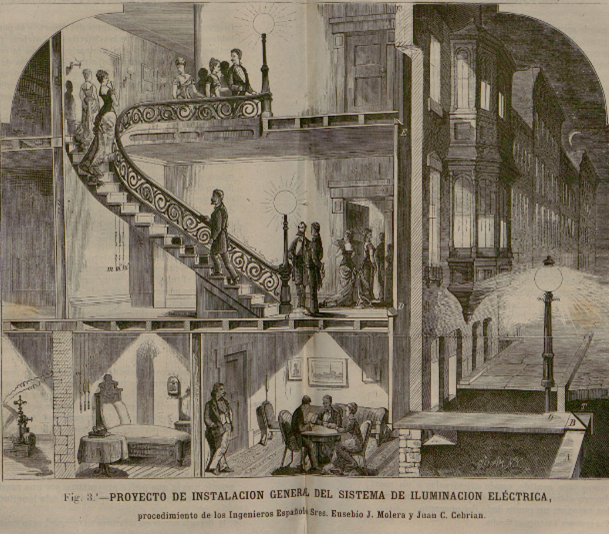
On January 10th, 1878, the Barcelona-based engineer Rafael Roig i Torres (1855-1931) published the first issue of Crónica Científica. Revista Internacional de Ciencias, a bi-monthly periodical with an exclusively scientific and technological content. Popular science journals were an uncertain business in Spain: previous attempts had often failed commercially, and science news was normally published in generalist publications side by side with political, philosophical, or literary content. Crónica Científica would do slightly better, issuing its last instalment fourteen years later, in 1892. The opening editorial in 1878 stated that the journal wanted to contribute to the “new era of moral, intellectual and material regeneration” that was taking hold of the country, and for which any scientific or technological development, however small, might be useful.[iv] The main target audience of the journal were Spanish school teachers, “whose interests and rights will be defended by all possible legal means,” in a country where, in spite of the improvements “in the previous thirty-two years,” public instruction was still very poor. And in what looks like a manifesto against controversies, Roig i Torres argued that the journal wanted to shy away from the disputes of “superficial intelligences who invade the scientific sphere,” and shed instead light on the real, actual scientific and practical work of practicing men of science, who normally remain silent in their laboratories, cabinets, herbaria, or geological museums.[v]
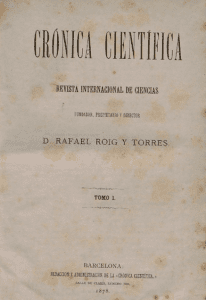
The opening editorial of Crónica Científica can help us set the stage for the role of engineers in Spanish science communication. A graduate in the exact sciences, a practicing engineer (first in the industries of telegraphy and engineering, later in agronomy), and a strong advocate for public instruction, Roig i Torres is an example of a group of actors often neglected in the histories of science popularization and concomitant controversies. The emphasis on communicating “real” and “hidden” scientific work contrasts with the customary spectacular, ideological or contentious tone of many science-related news in other media. At a time when “science” was slowly becoming a profession, a subject for public education and a synonym of progress in the public sphere, engineers often used their long-standing professional status and their commercial interests to soothe public debates about modern “science”, by portraying it in a more pragmatic, less confrontational guise.
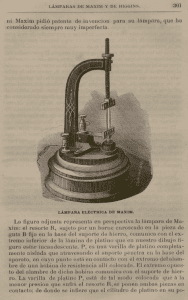
Crónica Científica kept a regular structure with sections on mathematics, astronomy, physics, meteorology, chemistry, natural history, medicine, and agriculture, as well as news on appointments and governmental legislation related to science and education. There was also a final section with practical problems for use in the classroom, normally related to the physico-mathematical sciences. Contributions were mostly locally produced by university and secondary-school professors, engineers, and members of various scientific academies, and they included “local” science and scientific news from abroad. This was an explicit distinction made by the journal, to stress and promote “national science”. Emphasis was placed on positive data and practical developments, rather than global philosophical interpretations or fundamental theories. Thus, one can find references to the functioning of telegraphy and electricity, paleontological and astronomical findings, or new chemical and agricultural techniques, many of which were related to the interests and professional activities of the editor.
Roig i Torres was also a Catholic, as were many of the contributors to the journal, like the doctor and paleontologist Joan Vilanova i Piera (1821-1893), the priest and geologist Jaume Almera i Comas (1845-1919), the astronomer and geologist José Joaquín Landerer (1841-1922) or the young Jesuit biologist Jaume Pujiula Dilmé (1869-1958). At a time when debates about evolution and Darwinism were highly polarized across the political and ideological spectrum, the contributions of these Catholic naturalists in Cróncia Científica show an attempt to find a middle way between the poles of the disputes. Thus, for instance, the laudatory tone of the obituary of Darwin in 1882, or the praise to many specific works of his as a naturalist, go hand in hand with the rejection of Darwinism as an all-encompassing theory, especially in relation to the origins of man. But even then, the tone is far from the insulting or ad hominem tone in simplistic rebuffs often found in many conservative Catholic popular publications at the time.[vi]
Another, similar periodical, which lasted much longer in Regenerationist Spain was Madrid Científico. First published in 1894, by two civil engineering students: Augusto Krahe (1867-1930) and Francisco Granadino (1865-1932). Initially, each issue of the journal printed two thousand copies and it survived commercially thanks to readers’ subscriptions, as well as advertisements from engineering companies. The editors made a point to emphasize that their magazine had no institutional support; on the contrary, they claimed that high-level officials were directly campaigning against them.[vii] In the periodical, one can find constant criticism of Spain’s red tape, bureaucrats in charge of the State’s apparatus, and politicians at large. Thus, Madrid Científico appeared more combative and belligerent than other publications produced by engineers.
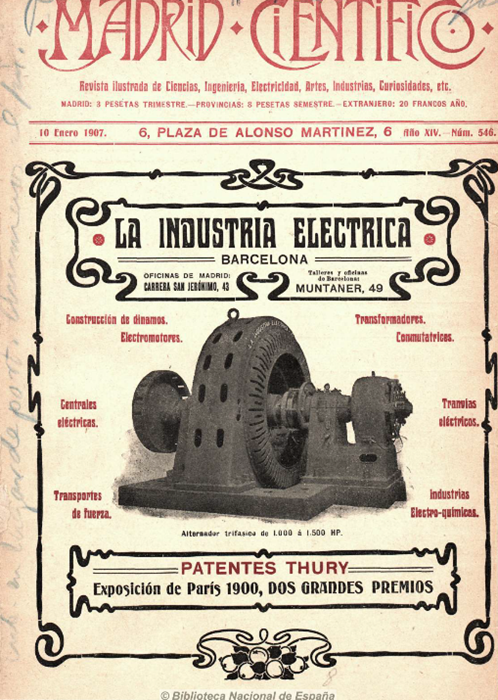
Madrid Científico asked its collaborators to write their articles as accessible as possible for a broader audience. The editors understood that technical knowledge had to be shared not only between professionals, as had so far been happening. In time, the editors of Madrid Científico hoped their journal would be a science popularization platform from which to build a public interest in the sciences. Thus, the interest in well-written, accessible articles was a priority with a twofold aim: to popularize science to the larger public and, of course, to increase the number of readers and ensure the commercial success of the journal. For instance, in one of the public searches for freelance collaborators, the editors stressed that “it is important that the collaborator’s products are liked by the public, that they are read; it is important that the collaborator manages to make his work light.”[viii]
The journal soon became popular among the educated public and this increased the willingness of engineers to collaborate and to contribute in the public discussion on how to modernize the country. A very telling example is the support given by some contributors to the public campaigns of Joaquín Costa (1846-1911), one of the most influential figures of the so-called Regenerationist movement in Spain. A lawyer, politician, historian and economist, Costa believed that the agricultural wealth of the country could be increased with the building of dams, and he campaigned for the establishment of a public hydraulic project, which caught the attention of some of Madrid Cientifico’s collaborators.
Among the many debates in the generalist press during Regenerationism, at least two of them were of particular interest for the reform of Spanish science as seen by Madrid Científico: education and Europeanization. In regard to education, a number of engineers claimed that true, modernizing education had to stress technology and practical matters and not simply so-called “pure” knowledge. In 1897, just as Cuba and the Philippines were about to be lost, some called for “[m]ore industrialists and less PhDs!” For some, the main problem was that the energies of the youth were wasted in offices of public administration and not invested in productive and economic goals.[ix] The competition between pure and applied knowledge was also at the center of the educational debate among the engineers of Madrid Científico at the turn of the century.
And yet, even though, according to some engineers, the scientific regeneration of the State should heavily rely on the growth of the applied sciences (a growth that had to be watered with technical and practical education), this didn’t mean that other forms of knowledge couldn’t also play a role in the general regeneration plan. The natural sciences, literature, philosophy and even theological studies should not be neglected, as “[i]t is obvious that the exclusive study of the so-called sciences par excellence would only lead to unstable minds.”[x]
“Europeanization” was another term often used in the debates on how to modernize Spain, with comparisons to other European countries common. The highlight of this debate in Madrid Científico was an exchange in 1902-03 between Eduardo Saavedra (1829-1912), a civil engineer and archaeologist, and Ramiro de Maeztu (1874-1936), a writer and politician. Saavedra challenged the concept of Europeanization because, in his view, it was progressively becoming an empty word “that is being used for every class of propaganda …, used as much to point at the arbitrary limits of newspaper articles, to justify the celebration of a children’s beauty competition, to ask for the reform of the Concordat or to speak about the inconveniences suffered by postmen in Madrid”.
Maeztu charged against this argument trying to give a well-defined meaning to the word and arguing that “Madrid Cientifico’s audience is naturally destined to play a central role” in such a project. Maeztu argued that a shared idea of Europe should not involve philosophical or political uniformity, since there were monarchies and republican regimes; and interestingly for our argument, it did not demand equality in religious beliefs:
“Within the European countries there are Catholics, Protestants, there are those where unbelievers reign; Japan has not needed to dispense with its polytheism to Europeanize itself; there are savage people that are Catholics and Protestants. Thus, religious ideas do not constitute anything fundamental in the Europeanization enterprise”.[xi]
Together with accounts on technology-related news, every scientific subject (both applied and theoretical) found a place in the pages of Madrid Científico. There was room to share knowledge about botany, zoology, and even architecture. There were also references to the scientific organization of labour, to labour-related illnesses, to legal frameworks, and so on. And yet, except for a few examples like Maetzu’s, there is hardly any mention of the debate between science and religion that was so preeminent in other Spanish journals at the time. This looks like quite a remarkable editorial choice. In its long life, only a handful of authors ventured into the religious debate; and when they did, it was seldom antagonistic to religion or to the Catholic Church.
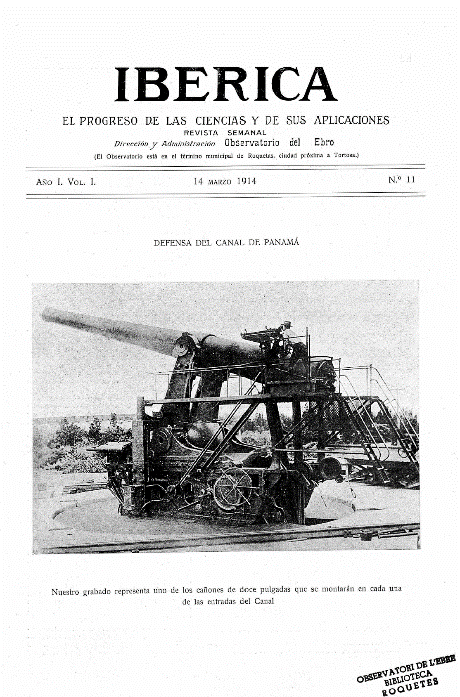
The last example we want to share is another long-running popular science journal, Ibérica: el progreso de las ciencias y de sus aplicaciones (Ibérica: the progress of the sciences and their applications). This was started in 1913 by the scientists at the Observatorio del Ebro, a seismological and astronomical observatory south of Barcelona, run by Jesuit scientists. It comes as no surprise that Ibérica defended the compatibility between science and faith, but it did so mostly by avoiding up-front discussions about controversial topics. There was an emphasis on the participation of the Jesuits and Catholics at large in the patriotic and religious duty of contributing to the development nationally of the natural sciences, technological innovation, and industrial growth. The editors indirectly followed an apologetic agenda, made explicit, for example, in the introductory editorial of the first issue. There, the reader could find a defence of modern science and a reassurance that everything in the journal would be sound and legitimately true:
“[T]he rationalist wanting to use science to attack the revealed truth, either using false facts or holding theories contrary to real phenomena will not be happy with this journal; but those in true and unbiased love of science will happily browse through the pages of this periodical. We shall never fear the facts as they are, we shall never deny scientific truth for fear that it contradicts revealed truth since we hold that God is the author of the natural as well as supernatural order.”[xii]
Most issues reported on subjects neutral to the debates on the truth and epistemic limits of science (as did Madrid Cientifico). The choice to focus the attention on technological, industrial, and engineering topics, as well as on military strategies and weaponry, or naturalist expeditions created a solid safeguard against what was seen by the editors as the ideological abuse of science by materialists, monists and extreme positivists. The confrontation between the Jesuits’ concept of legitimate science with these ideological stances surfaced only from time to time, particularly in discussions on theories about the origins of life.
However, the Jesuits of Ibérica were more interested in being regarded as promoters of science and technology and as contributors to the regeneration of Spain. For example, during the Great War, in which Spain benefited from its neutrality, local companies developed aircraft technologies. In this context, an editorial in Ibérica praised the national efforts to place Spain among the most developed, modern and refined countries, which would lead from this technological industriousness. The self-representation as agents of modernity and progress was the way the Jesuits of Ibérica found to counteract the anticlerical atmosphere that permeated some discourses on science and technology.
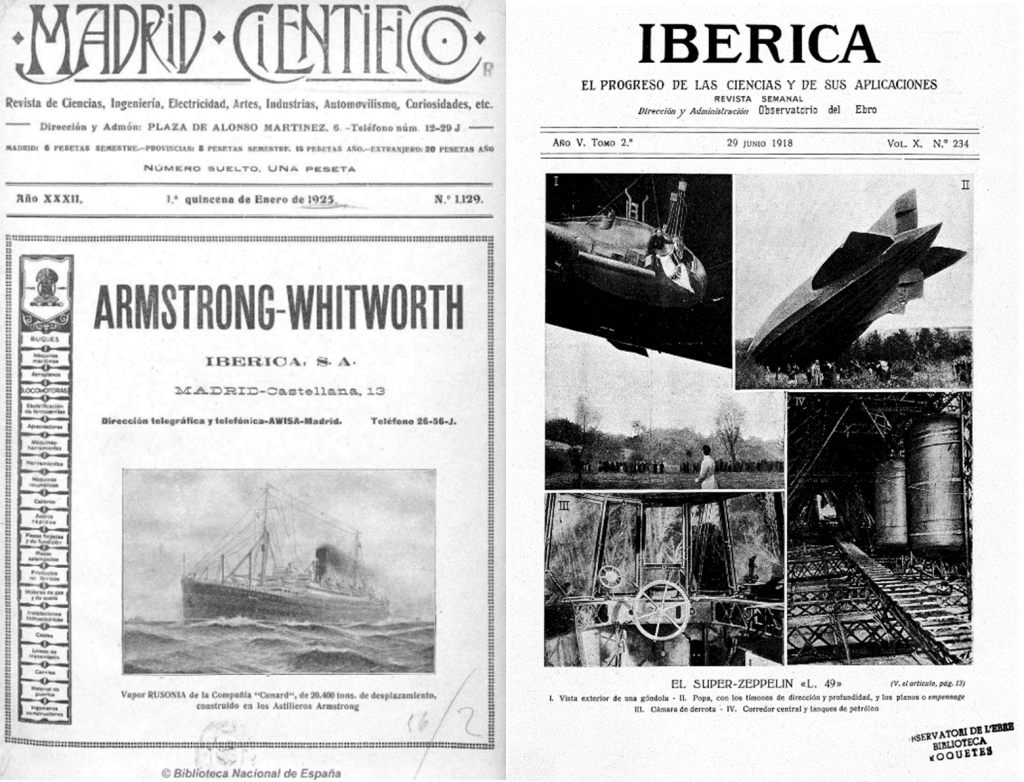
When we started reviewing the science popularization periodicals of Spanish civil engineers, we had hoped to find their positioning within the so-called conflict thesis. Ultimately, what we found was… almost no reference to it, as if such controversy was not worth their while. The Spanish conflict thesis was mainly brought into public debate by people in the humanities and in politics, and not by scientists. Spanish engineers active as science popularisers were certainly aware of the science-religion debate, but their focus in the theoretical and applied sciences (a pragmatic science) kept the debate at bay, usually participating in administrative, scientific, and technical controversies rather than in philosophical or theological disputes. This is especially clear in Crónica Científica and in Madrid Científico, both run by engineers. And when engineers participated in a journal like Ibérica, run by the Jesuits, they seldom addressed the supposed conflict between science and religion, but rather stuck to a concrete and pragmatic popularization of specific technologies.

The research that informed this piece was carried out under an INSBS small-research grant titled, “Engineers in Spanish “Science and Religion”. Historical origins of myths and contemporary uses”. For more research findings from the project, check out these other posts (in Spanish): on scientific dissemination in Ibérica and Madrid Ciencia; part II; and part III on controversies and conflicts.
Both Jaume Navarro and Javier Sierra de la Torre are historians based at the University of the Basque Country, for more on Jaume’s research interests see his Researcher Profile.
[i] Navarro, Jaume (2019) “Draper in Spain. The conflicting circulation of the conflict thesis” Zygon 54 (4), 1107-1124.
[ii] Hardin, Jeff, Numbers, Ronald and Binzley, Ronald, eds. (2018) The Warfare between Science and Religion: The Idea That Wouldn’t Die, Baltimore: Johns Hopkins University Press; Lightman, Bernard (2007) Victorian Popularizers of Science, Chicago: Chicago University Press; Bowler, Peter (2009) Science for All, Chicago: Chicago University Press.
[iii] Stanley, Mathew (2015) Huxley’s Church & Maxwell’s Demon, Chicago: Chicago University Press.
[iv] Crónica Cientifica, vol 1, 1878, p. 1.
[v] Ibidem, p. 3.
[vi] Navarro, Jaume (2022) “Evolution in times of political transformations. Science, religion and the media in Restoration Spain (1874-1898)”, in Lightman, B and Qidwai, S. eds. Global History of Evolution and Religion, Pittsburg University Press (in press).
[vii] Madrid Científico, Nº157 (1897), p. 1107-1108.
[viii] Madrid Científico, Nº378 (1902), p. 117.
[ix] Madrid Científico, Nº137 (1897), p. 873.
[x] Madrid Científico, Nº350 (1901) p. 258-261.
[xi] Madrid Científico, Nº400 (1902), pp. 337-338.
[xii] Ricardo Cirera, Ibérica, Nº Preliminar (1913), p.13.
